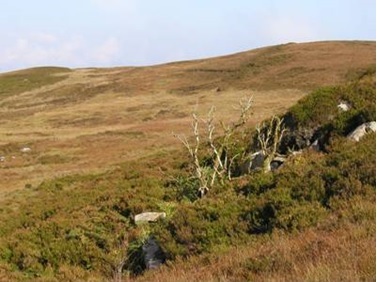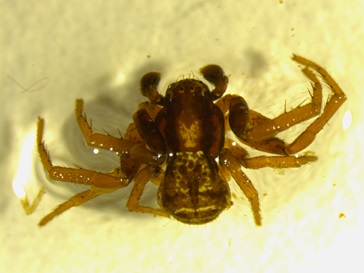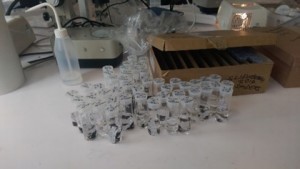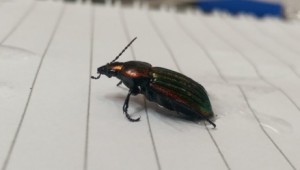
Hi everybody!
I’m Anna the TCV Natural Talent Entomology Trainee based with the Centre for Environmental Data and Recording (CEDaR) in Northern Ireland. I’m very excited to be starting my journey of Entomology and I’m looking forward to keeping you up to date with how I get on. As this is my first blog, I’m going to give some background into the organisation I’m with, the project I’m involved in and upcoming events I hope to be a part of.
CEDaR is responsible for collecting, organising, managing and distributing information that relates to habitats and the distribution of species within Northern Ireland (NMNI, 2014). I’m currently assisting with a project based at Queen’s University Belfast (QUB) which aims to quantify the impact of uncontrolled wildfires in Northern Ireland on habitats such as bog and dry and wet heathland. A total of 3,801 hectares of designated habitats within Areas of Special Scientific Interest (ASSIs) were burnt in Northern Ireland during the summer of 2011. The project also aims to investigate the recovery of damaged habitats over a three year period, by examining the community of species each year in both burnt and unburnt habitat to see if there is any change in the community structure over that time frame.

An example of typical upland habitat in Northern Ireland, at Slieve Beagh, one of the areas studied that is found between Counties Fermanagh, Monaghan and Tyrone (DOENI, 2010).
Why is this investigation important? This project is significant for four main reasons. Firstly the EC habitats Directive (92/43/EEC) recognises the significance of vegetation communities in upland heather moorland. These communities support a wide variety of fauna, such as the Irish hare (Lepus timidus hibernicus) and the Hen harrier (Circus cyaneus). This type of habitat therefore has environmental importance and so it is vital that we understand the impact of wildfires for the conservation of these habitats and the communities that depend on them. Secondly there is an increased risk of both accidental and intentional fires starting as recreational activities on upland areas become more popular. Therefore there is pressure to find out the full extent of the impacts of burning on these habitats and how quickly they can recover. Thirdly the risk of wildfires is likely to increase in temperate regions due to climate change and so it is essential to discover how burning alters community structure to determine the capacity of species to cope with this change. Finally I believe this project is particularly significant as there is both a lack of information on the potential impact of wildfires on less intensively managed sites such as those of upland areas and of the potential impacts on the invertebrate fauna of these sites.
This project is of particular interest to me as I have taken part in numerous Marsh Fritillary (Euphydryas aurinia) larvae web counts in many of the study areas of this project. When taking part in these surveys I was always fascinated by the wide variety of invertebrate species but did not have the expertise to identify them. This trainee-ship has given me the opportunity to develop this expertise and for that I am very grateful. My role involves sorting through pitfall traps placed during the summer and autumn of 2013 and 2014 to separate the ground beetles and spiders of each individual trap into sampling jars for later identification. As the title of this blog suggests I am currently focusing on assisting with the identification of spider species recovered from the pitfall traps and although identification is not always easy and the use of detailed taxonomic keys can be difficult at times, I feel that I am getting better and I am enjoying the identification process. I particularly enjoy the use of a powerful microscope in the QUB lab, as this allows for some amazing up close and personal photographs of usually overlooked species that are really quite stunning. Although I have always had a bit of a soft spot for spiders I am looking forward to assisting with the identification of ground beetles in the coming weeks.

The microscope camera highlights the amazing detail of some species such as this crab spider Oxyptila trux.
This year it is planned that I will light trap for moths at the CEDaR headquarters in Cultra (close to Bangor, County Down) at least once a month and I’m looking forward to what I will find. My first light trapping in the last week of January did not go so well. I knew before putting out the trap that my moth count was likely to be low at this time of year anyway so I wasn’t expecting great things. As it turned out I got no moths, but ironically I did get three spiders; which wasn’t a complete waste as I am studying them too after all. Fingers crossed I will have better luck next time!
2015 is CEDaR’s 20th Anniversary and there are a series of events to commemorate this achievement, to which I am very much looking forward to attending. I was fortunate to attend one of these events last week, a lecture by Dave Allen- an environmental consultant and experienced naturalist, with over 35 years’ experience in environmental recording. Dave’s very personal account of his experiences and involvement in environmental recording in Northern Ireland was inspiring, as I am presently involved in that type of work and hope to continue to do so in the future. This year I’m also looking forward to two Bioblitzes in the summer organised by CEDaR in White Park Bay, County Antrim and Murlough in County Down. Bioblitzes are events that take place over 24 hours at a particular site, during which time scientists, naturalists and members of the public try to identify as many species as possible. As an undergraduate Environmental Science student I have helped out at previous Bioblitzes in 2013 and 2014 to input collected data, however this year I hope to be confident in assisting experts with the identification of invertebrate species. I will update you in subsequent blogs. You can also follow TCV on twitter- @Natural_Talent for upcoming events from CEDaR.
Finally, I would like to give a big thank you to the Esmée Fairbairn Foundation, TCV and CEDaR for giving me the opportunity to develop my skills in environmental recording in Northern Ireland and I’m very much looking forward to the year ahead.
To find out more about the Natural Talent Traineeship, the Esmée Fairbairn Foundation, and CEDaR, please follow the links below.
Find out more about Natural Talent
Find out more about Esmée Fairbairn Foundation
Find out more about CEDaR


